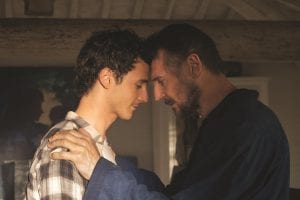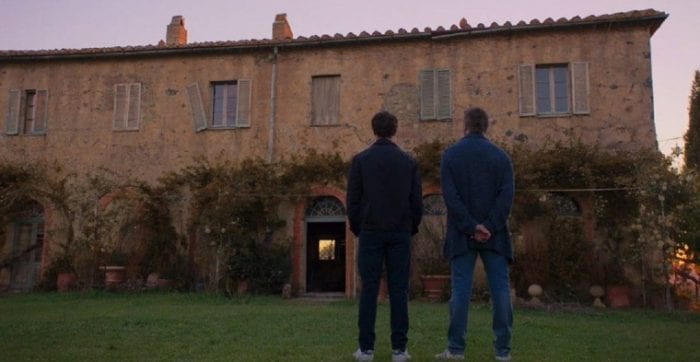Movie Review: Even Liam Neeson cannot salvage ‘Made in Italy’
Reviewed by Jeffrey Sanzel
The history of literature, theatre, film, and television is charged with the division between fathers and sons. It has shown the pain and the humor, the discord and the disconnect, the hurt and the healing. It has often been done with great skill and sensitivity.
Spoiler alert: Made in Italy isn’t one of them.
Corollary Spoiler alert: There’s nothing to spoil.

To say Made in Italy is the definition of predictable is an insult to all of the predictable films that have been … predictable. The film is being presented as a comedy-drama. This is true in that there is comedy and that there is drama. However, it is not so much blended as it is thrown together like two unrelated forms. Think mustard and sparkplugs.
The plot is simple. In London, twenty-something Jack Foster’s wife is divorcing him. He stands to lose his half of the gallery that they had managed together but which had belonged to her family. His only hope is to get his estranged father, Robert (a dysfunctional artist) to agree to sell the Tuscan house which they co-own. When they arrive, they discover the house is as neglected as their relationship. (How’s that for a metaphor? Do you think that maybe they’ll fix-up the house and rediscover the familial bond?) Over the next hour and thirty minutes, “secrets” (note the quotes; more to come) are “revealed.” (More quotes.)
Robert’s wife has died in a car accident years before. This event has driven a wedge between father and son. It’s not so much that Robert can’t communicate; it’s that he won’t. At first, he appears difficult and unpleasant but that goes by the wayside fairly quickly so he can be “wise” and “witty.” Jack and Robert’s relationship seems to be built on omission. Or maybe it’s just the script left things out — things like dimension and character motivation. But don’t worry, there’s some “funny” stuff with spaghetti.
Jack meets the village’s local restaurant owner, Natalia, who has a tense relationship with her ex-husband and a custody struggle over their daughter. Love springs between Jack and Natalia. Instantly.
There is slapstick. There are tears. There is forced laughter but little genuine mirth. The whole thing feels like a bad Hallmark connect-the-dots — or in this case, paint-by-numbers. The only thing more banal than the narrative is the dialogue that alternates between forced sitcom jokes and “deep” comments like “people are no good at seeing themselves.” (“Deep,” huh?)
There’s the standard beautiful Italian scenery juxtaposed with the whole range of rundown Money Pit jokes, with requisite dust, dirt, rusty water, and a weasel living in the bathroom. The fact that they are able to fix the house in what seems to be two days is due to myriad montages.

A mural that Robert painted in his darkest hour is on the main wall of the house. It is discussed, commented upon, and joked about. It represents the pain that Robert felt when he lost his wife. We know this because he tells us. So much for symbols or trusting your audience. Robert has hardened himself to his feelings. But has he? Robert cares about nothing. But wait, does he? Robert can’t deal with his son? But hold on, can he? And more “stuff.” (Last quotes.) Cue laughter. Cue tears. Cue revelations. Set up a conflict and then solve it instantly. Moving on. Nothing to see here. Literally. (Except the mural and the scenery.)
The responsibility for this unsavory stew falls squarely on first time writer-director James D’Arcy who has not succeeded as director but has failed as a writer. Any salvageable moments are due to Liam Neeson, as Robert; Neeson is an actor incapable of giving a bad performance. He does his best to infuse Robert with a bit of life and has been given a few substantial comedic and dramatic moments.
Neeson’s real-life son, Micheál Richardson, plays Jack. Whether his awkwardness is intentional or not, it kinda-sorta works (maybe a little). Valeria Bilello is charming as Natalia, but the character has truly nothing new to offer. Lindsay Duncan makes the most of the no-nonsense realtor, Kate, who is engaged to sell the house. She is a great actor and one wishes she had been given more to do. There are several people who come to look at the house and a few generic villagers; they have been handed what could charitably be called caricatures.
Finally, one can’t help thinking of the vague and truly uncomfortable life parallel. Neeson’s wife and Micheál’s mother was the gifted actor Natasha Richardson, who died tragically from head injuries sustained in a skiing accident in 2009. The shadow of this does a disservice to her memory, and somehow feels inappropriate and diminishing. While one would hope the creators’ were not using this particularly terrible event as a core, you can’t help but wonder. The reality is there and really can’t be denied. It is a sour coda to an unsatisfying film.
Rated R, Made in Italy is now streaming on demand.







